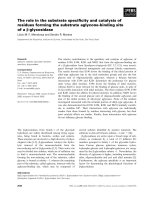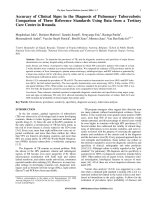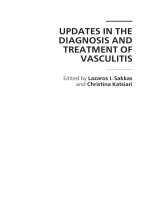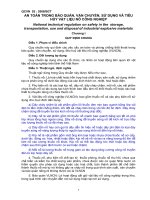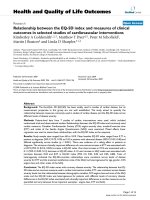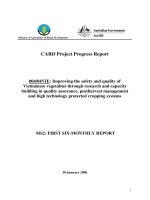Cardiac MRI in the diagnosis, clinical management and prognosis of arrhythmogenic right ventricular cardiomyopathy dysplasia
Bạn đang xem bản rút gọn của tài liệu. Xem và tải ngay bản đầy đủ của tài liệu tại đây (27.71 MB, 197 trang )
CARDIAC MRI
IN THE DIAGNOSIS,
CLINICAL MANAGEMENT
AND PROGNOSIS
OF ARRHYTHMOGENIC
RIGHT VENTRICULAR
CARDIOMYOPATHY/
DYSPLASIA
ELSEVIER
science &
technology books
Companion Web Site:
www.store.elsevier.com/9780128012833
Cardiac MRI in the Diagnosis, Clinical Management and Prognosis of Arrhythmogenic Right Ventricular
Cardiomyopathy/Dysplasia
Aiden Abidov, Isabel B. Oliva, Frank I. Marcus, Editors
Available Resources:
Extra content and support files.
T O O L S FOR ALLYOUR TEACHING N E E D S
textbooks.elsevier.com
ACADEMIC
PRESS
To adopt this book for course use, visit .
CARDIAC MRI
IN THE DIAGNOSIS,
CLINICAL MANAGEMENT
AND PROGNOSIS
OF ARRHYTHMOGENIC
RIGHT VENTRICULAR
CARDIOMYOPATHY/
DYSPLASIA
Edited by
Aiden Abidov
Isabel B. Oliva
Frank I. Marcus
Department of Medicine/Division of Cardiology
and Department of Medical Imaging,
University of Arizona, Tucson, AZ, USA
AMSTERDAM • BOSTON • HEIDELBERG • LONDON
NEW YORK • OXFORD • PARIS • SAN DIEGO
SAN FRANCISCO • SINGAPORE • SYDNEY • TOKYO
Academic Press is an Imprint of Elsevier
Academic Press is an imprint of Elsevier
125 London Wall, London EC2Y 5AS, UK
525 B Street, Suite 1800, San Diego, CA 92101-4495, USA
50 Hampshire Street, 5th Floor, Cambridge, MA 02139, USA
The Boulevard, Langford Lane, Kidlington, Oxford OX5 1GB, UK
Copyright © 2016 Elsevier Inc. All rights reserved.
No part of this publication may be reproduced or transmitted in any form or by any means,
electronic or mechanical, including photocopying, recording, or any information storage and
retrieval system, without permission in writing from the publisher. Details on how to seek
permission, further information about the Publisher’s permissions policies and our arrangements with organizations such as the Copyright Clearance Center and the Copyright Licensing Agency, can be found at our website: www.elsevier.com/permissions.
This book and the individual contributions contained in it are protected under copyright by
the Publisher (other than as may be noted herein).
Notices
Knowledge and best practice in this field are constantly changing. As new research and experience broaden our understanding, changes in research methods, professional practices, or
medical treatment may become necessary.
Practitioners and researchers must always rely on their own experience and knowledge
in evaluating and using any information, methods, compounds, or experiments described
herein. In using such information or methods they should be mindful of their own safety
and the safety of others, including parties for whom they have a professional responsibility.
To the fullest extent of the law, neither the Publisher nor the authors, contributors, or editors, assume any liability for any injury and/or damage to persons or property as a matter
of products liability, negligence or otherwise, or from any use or operation of any methods,
products, instructions, or ideas contained in the material herein.
British Library Cataloguing-in-Publication Data
A catalogue record for this book is available from the British Library
Library of Congress Cataloging-in-Publication Data
A catalog record for this book is available from the Library of Congress
ISBN: 978-0-12-801283-3
For information on all Academic Press publications
visit our website at />
Publisher: Mica Haley
Acquisition Editor: Stacy Masucci
Editorial Project Manager: Sam W. Young
Production Project Manager: Chris Wortley
Designer: Matthew Limbert
Typeset by Thomson Digital
Printed and bound in United States of America
Dedication
To my dear wife, Yulia: thank you for always being there for me, being
my pillar of strength, and supporting me through anything and everything I aspired to achieve.
To my dear kids Elnur, Amir, Meira, and Dan: thank you for always
inspiring me and making me strive to be the best dad I could be. I love
you all so much.
Aiden Abidov
To my caring husband, Felipe: You are the love of my life! Thank you
for your continuous support and love, you make me a better person.
To my little Sophia: You are my life, we love you more than anything
in this world.
To my parents, brother, and sister: Thank you for your love and for
raising me to be the best I can be. Your successes have always inspired me;
I miss you all every day!
Isabel Oliva
To my understanding wife, Janet who has tolerated her workaholic
husband for many years.
Frank I. Marcus
v
Acknowledgment
The authors are indebted to Mrs Yvette M. Barnes, MEd for technical
assistance in the preparation and submission of the manuscript.
vi
List of Contributors
Aiden Abidov Department of Medicine/Division of Cardiology and
Department of Medical Imaging, University of Arizona, Tucson, AZ, USA
Cristina Basso Department of Cardiac, Thoracic and Vascular Sciences,
University of Padua Medical School, Padua, Italy
Maarten J. Cramer Department of Cardiology, University Medical Center
Utrecht, Utrecht, The Netherlands
Pieter A. Doevendans Department of Cardiology, University Medical Center
Utrecht, Utrecht, The Netherlands
Arun Kannan Department of Medicine/Division of Cardiology and
Department of Medical Imaging, University of Arizona, Tucson, AZ, USA
Frank I. Marcus Department of Medicine/Division of Cardiology and
Department of Medical Imaging, University of Arizona, Tucson, AZ, USA
Thomas P. Mast Department of Cardiology, University Medical Center Utrecht,
Utrecht, The Netherlands
Luisa Mestroni Cardiovascular Institute, University of Colorado Anschutz
Medical Campus, Aurora, CO, USA
Isabel B. Oliva Department of Medicine/Division of Cardiology and
Department of Medical Imaging, University of Arizona, Tucson, AZ, USA
Ahmed K. Pasha Department of Medicine/Division of Cardiology and
Department of Medical Imaging, University of Arizona, Tucson, AZ, USA
Amit Patel Cardiovascular Institute, University of Colorado Anschutz Medical
Campus, Aurora, CO, USA
Kalliopi Pilichou Department of Cardiac, Thoracic and Vascular Sciences,
University of Padua Medical School, Padua, Italy
Stefania Rizzo Department of Cardiac, Thoracic and Vascular Sciences,
University of Padua Medical School, Padua, Italy
Arco J. Teske Department of Cardiology, University Medical Center Utrecht,
Utrecht, The Netherlands
Gaetano Thiene Department of Cardiac, Thoracic and Vascular Sciences,
University of Padua Medical School, Padua, Italy
xi
C H A P T E R
1
Introduction
Frank I. Marcus, Aiden Abidov
Department of Medicine/Division of Cardiology
and Department of Medical Imaging,
University of Arizona, Tucson, AZ, USA
This book aims to evaluate the role of the MRI in the diagnosis, clinical management, and prognosis of arrhythmogenic right ventricular
cardiomyopathy/dysplasia (ARVC/D). You may ask “Isn’t this too narrow
a focus for this rare disease?” Let us evaluate this concern.
First, ARVC/D is now more frequently diagnosed as it is becoming better
known. It is estimated that it occurs in 1:5000 individuals but it may be present
in a higher incidence since one may have a pathological gene for this disease
yet have little or no clinical manifestations. This is known as a lack of association of genotype and phenotype. Thus, ARVC/D may be a less rare disease
than is presently thought. In addition, since it is a cause of sudden cardiac
death, particularly in the young, it is important to be able to recognize it in
order to prevent this catastrophic event.
Another question is, why should we focus our attention on one imaging modality, the MRI, particularly when this imaging modality is more
expensive and less readily available than 2D echocardiography? In contrast to echocardiography, an MRI can provide more accurate quantitative evaluation of the right ventricular function and structure. Specifically,
it can accurately access right ventricular ejection fraction as well as segmental wall motion abnormalities of the right ventricle. Based on hundreds of published papers, cardiac MRI is a useful diagnostic imaging
modality in patients suspected of having ARVC/D and is particularly
valuable since important limitations of MRI (such as the need for breathholding, inability to scan patients with permanent pacemakers or ICDs,
etc.) have largely been overcome. The finding of abnormal right ventricular function or structure by 2D echocardiogram in a patient suspected
of having ARVC/D should be confirmed by MRI since the latter is more reliable for the diagnosis. It is also important that the radiologist/cardiologist
who is interpreting the MRI should be aware of normal variants of the
Cardiac MRI in the Diagnosis, Clinical Management and Prognosis of Arrhythmogenic Right Ventricular Cardiomyopathy/Dysplasia
Copyright © 2016 Elsevier Inc. All rights reserved.
1
21.
Introduction
right ventricular contractility patterns, particularly that of an apparent
bulging of the right ventricular free wall at the insertion of the right
ventricular papillary muscle.
Other questions include the age at which ARVC/D is manifest. Should an
MRI be done in children who have the genetic abnormality but no clinical
manifestation of the disease? How rapidly do the abnormalities of the RV
change in this disease? This would determine how frequently the MRI
should be reassessed in first-degree relatives who may have no or minimal
symptoms.
An important consideration is the increased safety of MRI, especially
absence of exposure to ionizing radiation and nephrotoxic iodine contrast.
This allows sequential MRI studies in young patients without increased
associated risk of imaging. Excellent spatial resolution and safety of cardiac MRI makes it an ideal methodology for follow-up of patients with
known or suspected ARVC/D.
Finally, the MRI is useful in differential diagnosis that includes
several conditions mimicking ARVC/D, such as cardiac sarcoidosis, leftto-right supraventricular shunts, and myocarditis. Also, in some cases,
myocardial–pericardial adhesions can cause abnormal right ventricular
wall motion. The use of gadolinium contrast to detect and localize scar/
fibrosis in the left or right ventricular myocardium is unique to MRI, as
is the ability of cardiac MRI to provide effective tissue characterization,
including fibro-fatty infiltration, inflammation, thrombosis, etc.
Recent developments in the field of advanced echocardiography, cardiac CTA, and nuclear cardiology have many interesting applications
that could significantly enhance the armamentarium of physicians in the
diagnosis and management of ARVC/D. In this book, we included a brief
overview of novel non-MRI-based imaging methodologies that are useful
in this disease.
In summary, there are many important clinical areas of interest reflecting the role of the MRI and other rapidly developing cardiac imaging
methodologies in patients with ARVC/D. In our book, we provide our
readers with a convenient overview of these areas.
However, there are three types of problems with cardiac imaging in general, and cardiac MRI in particular for the evaluation of ARVC/D. (Fig. 1.1):
1. The problem of ordering the right test for the patient’s age and
clinical presentation. Patients with known or suspected ARVC/D are
a highly heterogeneous group and include patients with confirmed
ARVC/D, asymptomatic gene carriers, and relatives of patients with
ARVC/D, as well as patients with suspected or possible ARVC/D.
There is significant disagreement about which test should be utilized
in these populations, which one is the most effective for screening,
and whether the layered testing concept should be considered in the
1. Introduction
3
FIGURE 1.1 Problems encountered in evaluation and management of patients with
known or suspected ARVC/D.
“borderline” cases. The Modified Task Force criteria focused on the
specificity of echo and MRI measurements of ARVC/D and possibly
at the expense of sensitivity, particularly of early or clinically “silent”
disease cases.
2. The problem of performing a good-quality diagnostic MRI. For
years, we have been reviewing MRI studies of patients with either
known or probable disease performed in imaging laboratories from
many centers in the United States and abroad. There is marked
variability of the diagnostic quality of these studies. Also, there
are many MRI protocols utilized in different centers. Current lack
of standardization in MRI protocols for the ARVC/D patients is
concerning. There is an urgent need to improve this situation.
3. The problem of interpreting results of the MRI study. Even negative
results in particular clinical populations may mean just one negative
diagnostic criterion among many others that must be considered in
such a complex diagnosis as ARVC/D. At times the decision-making
process is based completely on the imaging study. A false-negative
study can be associated with increased risk, and a false-positive test
may dramatically change the patient’s life and have long-lasting
consequences both for the patient and for the society. One of these
situations we have encountered is implantation of ICDs in young
patients who have borderline tests, or tests that are negative but
are interpreted as positive even though other diagnostic tests were
41.
Introduction
not considered. Recently, with the development of genetic testing,
interpretation of imaging test results in association with genetic
defects in asymptomatic individuals raises important clinical
decisions. These patients may be subjected to changes in their
occupation, limitations in their athletic activities (such as college
sports) and lifestyle even though their anatomic data do not suggest
an increased risk.
In this book, we address these problems and provide quick access to
evidence-based algorithms and methods utilized currently in the stateof-the-art imaging laboratories. We have utilized an exhaustive literature search, but we also give readers flow diagrams, clinical algorithm
schemes, and figures. Easy access to these data may save time and effort
in reaching important clinical decisions and utilize an important principle of the modern imaging: “The right test for the right patient.”
This book provides a quick reference to assist with standardization of
the imaging protocols, particularly for the practicing imagers and clinicians who may encounter patients with known or suspected ARVC/D.
This book is designed to be user friendly. We provide clinical examples
as well as online tools and videos to illustrate interesting cases from our
practice.
We hope to have the readers’ feedback and maintain online communication with interested clinicians and researchers in order to further enhance
the potential of cardiac MRI and other imaging modalities in the diagnosis
and management of ARVC/D.
C H A P T E R
2
Arrhythmogenic
Cardiomyopathy: History
and Pathology
Gaetano Thiene, Stefania Rizzo,
Kalliopi Pilichou, Cristina Basso
Department of Cardiac, Thoracic and Vascular Sciences,
University of Padua Medical School, Padua, Italy
INTRODUCTION
Arrhythmogenic right ventricular cardiomyopathy dysplasia (ARVC/D)
is a life-threatening entity, which has drawn the attention of the scientific
community for the last 30 years since it is a significant cause of premature
death [1,2]. Young people, especially athletes, may die suddenly because of
abrupt lethal cardiac arrhythmias, namely ventricular fibrillation, precipitated by exercise [3]. The present chapter will deal with some aspects of the
disease: history, terminology, biological background, pathology, and morphological criteria for diagnosis, endomyocardial biopsy, and recapitulation
of the disease in transgenic mice.
HISTORY
It is a “rediscovered” disease, since its knowledge dates back centuries.
The early description belongs to the pathologist Giovanni Maria Lancisi,
who first described its heredofamilial peculiarity [4]. In a chapter on hereditary predisposition to cardiac aneurysms and bulgings in his book
De Motu Cordis et Aneurysmatibus (on the movements of the heart and
aneurysms), he reported the history of a family with disease recurrence
in four generations, featured by cardiac palpitations and sudden death.
Cardiac MRI in the Diagnosis, Clinical Management and Prognosis of Arrhythmogenic Right Ventricular Cardiomyopathy/Dysplasia
Copyright © 2016 Elsevier Inc. All rights reserved.
5
62.
Arrhythmogenic Cardiomyopathy: History and Pathology
FIGURE 2.1 First historical description of ARVC/D in the book De Motu Cordis et
Aneurysmatibus published in 1736 by Giovanni Maria Lancisi, Professor of Anatomy in
Rome and Pope’s Physician. Courtesy of Arnold Katz.
ilatation and aneurysms of the right ventricle (RV), which filled the right
D
chest, were observed at autopsy (Fig. 2.1).
René Laennec, the French doctor and inventor of the stethoscope, in the
book “De l’auscultation mediate ou traite9 du diagnostic des maladies des poumons
et du Coeur” (on the mediated auscultation and treatise of the diagnosis of
lung and heart disease) published in 1819, first drew attention to the relationship between fatty tissue in the right ventricle (RV) and sudden death [5].
The walls were described as extremely thin “especially at the apex of the
heart and the posterior side of the right ventricle.” The risk of sudden death
in a fatty heart was confirmed by the protagonist Dr. Lydate in Middlemarch of George Eliot in 1871, who, talking to his patient, said, “You are suffering from what is called fatty degeneration of the heart… it is my duty to
tell you that death from the disease is often sudden…” [6]. In 1905 William
Osler, in his famous treatise “The Principles and Practice of Medicine”, described a case of a 40-year-old man, who died suddenly while climbing up a
hill. The heart showed biventricular massive myocardial atrophy with very
thin walls, as to be named “parchment heart” [7]. The specimen is now part
of the Abbott collection in Montreal and was reviewed by Segall in 1950 [8].
In 1952, Uhl reported the fatal case of an infant, which has been the
source of misconception and controversy [9]. A female infant died at the
age of 8 months, with congestive heart failure and at autopsy showed “almost total absence of the myocardium in the right ventricle in the absence
of fatty tissue.” “Examination of the cut edge of the ventricle wall reveals
it to be paper-thin with no myocardium visible….”
History
7
The eponym Uhl’s anomaly has been employed in adults with parchment RV. It is now also clear that the papyraceous appearance of the ventricular free wall is the end stage of an acquired, genetically determined
progressive loss of myocardium, as in the Osler case [10].
The infant reported by Uhl was affected by a cardiac structural defect
present at birth and, as such, falls into the category of congenital heart disease. Nonetheless, we cannot exclude that in infants with Uhl’s anomaly
the myocyte loss might have started during fetal life.
The history of the disease at our university started in the 1960s, when
Professor Sergio Dalla Volta, the founder of modern cardiology in Padua
with cardiac catheterization, published a series of cases featured haemodynamically by “auricularization of the right ventricular pressure” to underlie the absence of an effective systolic contraction of the RV, when a
pressure curve was recorded in the RV similar to that of the right atrium,
with the blood pushed from the right atrium directly to the pulmonary
artery [11,12]. Thirty years later the heart of one of these patients was studied following cardiac transplantation at the age of 65, and had a parchment RV with an almost intact left ventricle [2].
In 1978, the late Professor Vito Terribile of our institute performed an
autopsy of a woman with a history of palpitations and congestive heart
failure, who died of pulmonary thromboembolism. The heart showed
dilatation of the RV with mural thrombosis, “adipositas cordis” even at
the posterior wall and apex (like the Laennec description), and “myocardial sclerosis of the left ventricle” in the absence of coronary artery disease, in keeping with what we now call biventricular arrhythmogenic
cardiomyopathy.
The arrhythmic propensity of this substrate was first discovered in the
1970s by Guy Fontaine who demonstrated that life-threatening ventricular
tachyarrhythmias with left bundle branch block morphology can originate
from the RV [13]. The basal ECG may show delayed depolarization with an
epsilon wave at the end of the QRS complex, which he named post-excitation
syndrome. This differs from the pre-excitation syndrome (Wolff–Parkinson–
White syndrome) with delta wave preceding the QRS complex.
In the 1980s, Marcus and Fontaine [14] reported a series of adult patients with this disease presenting with ventricular arrhythmias with left
bundle branch block morphology. Microscopic examination of myocardial
samples, removed at surgical disconnection of the right from the left ventricle, disclosed fibrofatty replacement that the authors interpreted as a
maldevelopmental defect, and called the disease “right ventricular dysplasia.” The term was then replaced by cardiomyopathy in the WHO nomenclature and classification of heart muscle disease [15].
The study of Marcus et al. was limited to adult patients and the ventricular arrhythmias of RV origin that were neither considered malignant
nor interpreted as an inherited disease [14].
82.
Arrhythmogenic Cardiomyopathy: History and Pathology
Meanwhile knowledge of the disease made progress in Padua, thanks
to Andrea Nava, a true pioneer in the field of cardiovascular clinical genetics. He realized the genetic inheritance of the disease with a Mendelian
dominant transmission, introducing the concept of “genetically determined cardiomyopathy,” since he showed the onset of the phenotype in
childhood [16,17].
Thiene et al. [3] first draw the attention to the malignant aspect of the
disease, presenting in youths with sudden death, even as its first manifestation. By collecting and studying all the cases of juvenile sudden death
(<35 years) occurring in the Veneto region, Italy (nearly 5 million inhabitants), they showed that ARVC/D is a leading cause of sudden death
in young athletes (Fig. 2.2). The subjects had inverted T waves in right
precordial leads and apparently benign premature ventricular beats with
left bundle branch block morphology in the ECG, which is compulsory
in Italy for sports eligibility. In other words, it was demonstrated that the
FIGURE 2.2 A 30-year-old athlete who died suddenly during a soccer game and included in the original series published in 1988: note the inverted T waves in the right
precordial leads. At postmortem, the left ventricle was normal, whereas the right ventricle
showed fibrofatty replacement of the free wall with inferior aneurysm. Modified from Ref. [1].
History
9
RV may be similar to the left ventricle in hypertrophic cardiomyopathy
[18] and ischemic heart disease, and that ARVC/D may be a cause of
premature death. Awareness of the heredofamilial nature of the disease
stimulated molecular genetic investigation. By linkage analysis, the locus of a possible gene mutation was mapped to 14q23-q24 [19], oddly
enough in the same chromosome of b-myosin heavy chain mutation in
hypertrophic cardiomyopathy. At that time, there was no information
on which gene might be the culprit, certainly neither sarcomeric genes
since there was no evidence of hypertrophy and disarray, nor cytoskeleton and dystrophin complex as in dilated cardiomyopathy, since mechanical contractility was fairly preserved in the left ventricle. A revealing idea came from a group of Greek scholars from Naxos Island. In a
letter to the editor, following our publication on ARVC/D and sudden
death in the young, they drew the attention of the scientific community to
a recessive cardiocutaneous syndrome, combining ARVC/D phenotype
and palmoplantar keratosis and woolly hair [20,21]. Both epidermal and
cardiac cells possess cell junction apparatus, ensuring mechanical adherences. Thus, protein genes of the desmosomal apparatus became candidates. Soon thereafter, a research group from Heidelberg demonstrated
that knock-out transgenic mice for the JUP (plakoglobin gene), namely
gamma catenin, resulted in severe myocardial injury with almost disappearance of desmosomes and spontaneous cardiac rupture during fetal
life [22]. The authors said that “the human plakoglobin gene is located on
chromosome 17q21, a region not yet identified in human cardiomyopathy
patients.”
As a consequence, JUP immediately became the candidate gene for
Naxos disease. Linkage analysis was carried out in Naxos families, identifying the gene defect in locus 17q21 [23]. Subsequent gene sequencing
proved that the molecular defect consists of a deletion of the JUP gene
[24]. At about the same time, a dermatologist from Ecuador, Luis Carvajal Huerta, described another recessive cardiocutaneous syndrome, consisting of biventricular cardiomyopathy, woolly hair and palmoplantar
keratosis quite similar to Naxos disease, with pump failure and rare polymorphic ventricular arrhythmias [25]. A mutation was demonstrated in
a gene, encoding a major protein of the desmosomal apparatus, namely
desmoplakin (DSP) [26]. One child of the original family reported by Carvajal died with congestive heart failure and the wife of Carvajal, sent the
heart specimen to Dr. Saffitz in St. Louis [27]. Gaetano Thiene was asked
to review the heart and found that it had a right ventricle fibrous replacement and typical aneurysms in the “triangle of dysplasia.” The left ventricle was dilated and had a mural thrombus consistent with biventricular
arrhythmogenic cardiomyopathy.
In Padua, we were looking for a candidate gene for the dominant variant of ARVC/D, pointed to DSP and a missense mutation was identified in
102.
Arrhythmogenic Cardiomyopathy: History and Pathology
some of Nava’s families [28]. Genotype–phenotype correlations demonstrated that DSP proteins frequently presented with biventricular or even
predominant left ventricular involvement [29].
Subsequently, other genes encoding desmosomal proteins were investigated in nonsyndromic ARVC/D patients and missense mutations
were found in plakophilin-2 (PKP2), desmoglein-2 (DSG2), and desmocollin-2 (DSC2) [30–33]. Eventually both recessive and dominant variants of
ARVC/D were found to be related to cell junction defects, so that the disease could be labeled as a desmosomal disease [34–36] (Fig. 2.3).
Basso et al. revealed ultrastructural abnormalities of the desmosome
in the myocardium of genotyped ARVC/D patients, and suggested that
disruption of the intercalated disc might be the final common pathway of
a genetically determined myocyte death, resulting in fibrofatty scarring
and arrhythmogenicity [37].
Nondesmosomal genes, such as transforming growth factor b (TGFb3), transmembrane protein 43 (TMEM43), alpha-T catenin (CTNNA3),
titin (TNT), desmin (DES), PLN (phospholamban), and LMNA (lamin
A/C), have also been found [38–44].
Ryanodine receptor 2 (RyR2), originally reported as a form of ARVC/D,
was eventually related to a distinct morbid entity (catecholaminergic
polymorphic ventricular tachycardia), an ion channel disease without
substrate [45].
Transgenic mice overexpressing the mouse homologous of desmosomal gene mutation were generated [46–49]. In the desmoglein transgenic
mouse, published by Pilichou et al. [49], the recapitulated disease consists
of dilatation and aneurysm of both ventricles with fibrous replacement
of the myocardium, prolonged electrical epicardial ventricular activation
at electrophysiology, tachyarrhythmias, and even sudden death. It was
then shown by Rizzo et al. [50] that delayed electrical ventricular activation and arrhythmia inducibility occurs well before the onset of myocyte
death and scarring, as a consequence of Na++ current density. This is
most probably due to cross talk between cell junction and sodium channel complex, consistent with the existence of an electrical disturbance
even in the early stages of ARVC/D.
The discovery of ARVC/D as a distinct biological nosographic entity,
with a specific genetic background, was paralleled by advances in diagnosis and treatment.
Diagnostic criteria have been published in 1994 based on noninvasive (ECG, echo) and invasive (angiography, endomyocardial biopsy)
studies [51] (Fig. 2.4). In 2010, diagnostic criteria were updated including
quantitative parameters [52], even for endomyocardial biopsy [53].
Cardiac magnetic resonance (CMR) was found to be an excellent
diagnostic procedure, to detect both morphofunctional (poor contractility, ventricular dilatation, aneurysms, and dyskinesia) and tissue
History
11
FIGURE 2.3 Intercellular mechanical junction (desmosome) of the cardiomyocyte.
(A) Transmission electron microscopy of cardiomyocyte desmosome (boxed area)×80.000.
(B) Schematic representation of the desmosome components. It consists of a core region,
which mediates cell–cell adhesion, and a dense plaque, which provides attachment to the
intermediate filaments. There are three major groups of desmosomal proteins: (1) transmembrane proteins (i.e., desmosomal cadherins) including desmocollin and desmoglein;
(2) Desmoplakin (DSP), a plakin family protein that binds directly to intermediate filaments
(desmin in the heart); and (3) linker proteins (i.e., armadillo family proteins) including
plakoglobin and plakophilin, which mediate interaction between the desmosomal cadherin
tails and DSP. IF, Intermediate filaments; PM, plasma membrane. Modified from Ref. [35].
122.
Arrhythmogenic Cardiomyopathy: History and Pathology
FIGURE 2.4 Diagnostic morphofunctional, electrocardiographic, and tissue characteristic features of ARVC/D. (A) Diagram of the “triangle of dysplasia,” which illustrates the
characteristic areas for structural and functional abnormalities of the RV (LV, left ventricle;
RA, right atrium; RV, right ventricle); (B) 2D echocardiography showing RV outflow tract enlargement from the parasternal short-axis view (AoV, aortic valve; LA, left atrium; RA, right
atrium; RVOT, right ventricle outflow tract); (C) RV contrast angiography (30° right anterior
oblique view) demonstrating localized RVOT as well as inferobasal aneurysms (arrows) with
mild tricuspid regurgitation; (D) endomyocardial biopsy sample with extensive myocardial
atrophy and fibrofatty replacement (trichrome; ×6); (E) 12-lead ECG with inverted T waves
(V1, V2,V3), with left bundle branch block (LBBB) morphology premature ventricular beats
and ventricular tachycardia (VT); (F) ECG tracing showing postexcitation epsilon wave in
precordial leads V1,V2, V3 (arrows); (G) signal-averaged ECG with late potentials (40-Hz highpass filtering); filtered QRS duration (QRS), 217 ms; low amplitude signal (LAS), 107 ms, and
root-mean-square voltage of terminal 40 ms (RMS), 4 mV; (H) family pedigree of ARVC/D:
note the autosomal dominant inheritance of the disease with 50% of offspring affected.
Modified from Ref. [35].
characterization, for both fatty tissue and fibrosis by the late enhancement
technique. The use of CMR with gadolinium is extremely effective in detecting left ventricular involvement [54] (Figs 2.5 and 2.6).
Electroanatomic mapping (EM) was able to reveal “electric scars,”
namely areas of reduced or absent electrical activity, equivalent to fibrofatty myocardial atrophy. The correlation with endomyocardial biopsy
and MRI was important for the differential diagnosis with nonischemic
arrhythmogenic diseases like sarcoidosis, myocarditis, RV outflow tract
tachycardia, and Brugada syndrome [55–58].
Meanwhile, great advances have been achieved in the prevention of
premature death in ARVC/D. Lifestyle and sports disqualification, by
detecting ECG-specific alterations (T wave inversion in right precordial
leads, QRS widening, and epsilon postexcitation wave) can be lifesaving, considering that physical activity is the main precipitating factor of
History
13
FIGURE 2.5 Electroanatomic mapping is a fundamental tool in the differential diagnosis
between segmental infundibular arrhythmogenic right ventricular cardiomyopathy (left panel) and idiopathic right ventricular outflow tract tachycardia (right panel). Modified from Ref. [1].
FIGURE 2.6 Electroanatomic mapping (EM) is more sensitive than cardiac magnetic resonance with late enhancement to detect right ventricular involvement in arrhythmogenic right
ventricular cardiomyopathy. However, the left ventricle is frequently involved, and may be considered the ‘mirror’ of the right ventricle on cardiac magnetic resonance. Modified from Ref. [1].
142.
Arrhythmogenic Cardiomyopathy: History and Pathology
FIGURE 2.7 ICD therapy in ARVC/D. (A) Projected survival of 132 patients with ARVC/D
who had implanted cardiac defibrillator (ICD). The Kaplan–Meier analysis compares actual
patient survival (continuous line) with survival free from either VF or ventricular flutter (dotted
line) that would have been probably fatal in the absence of an appropriate ICD intervention. The
divergence between curves reflects the estimated survival benefit conferred by ICD therapy. At
36 months, actual total patient survival was 96%, compared with 72% VF and ventricular flutter
survival. (B) Stored intracardiac electrogram in an ARVC/D patient. This shows one episode of
VF, with appropriate detection and successful ICD discharge followed by sinus rhythm. Modified
from Ref. [35].
cardiac arrest [59–61]. Drug therapy and ablation, although palliative
measures, are of help [62–64]. A cardiac defibrillator, either implantable
or external, can revert cardiac arrest, due to ventricular fibrillation [65,66]
(Fig. 2.7).
However, cure rather than palliation of ARVC/D should be pursued,
by intervening in the pathobiology of the disease, namely the onset and
progression of cell death leading to myocardial dystrophy. Arrhythmias
should not be the only target in patients with ARVC/D to prevent sudden
death [62] (Fig. 2.8).
Pathology and endomyocardial biopsy
15
FIGURE 2.8 Cardiac arrest is the combination of trigger, substrate, and arrhythmic
mechanism. Sport acts as a trigger; drug therapy and ablation are palliative measures. Defibrillator clearly intervenes on the mode of cardiac arrest, namely ventricular fibrillation.
The true disease prevention and cure should point to onset and progression of the substrate.
Cellular reprogramming of somatic cells into pluripotent stem cells
(iPSCs) enables patient-specific in vitro remodeling of human genetic
disorders for pathogenetic investigation and drug screening [67–69].
Fibroblasts of patients affected by ARVC/D may be used to generate autologous cardiomyocytes. Zebrafish model may also be employed in the
study of ARVC/D to elucidate pathogenetic mechanisms and screen drug
therapy [70].
Engineering adeno-associated viral vectors containing c-DNA of wildtype desmosomal genes, which may be transferred into the heart, may
represent a curative gene therapy [71].
We are entering the era of molecular medicine, and the time has come
for myocardial dystrophy (ARVC/D) as it has been for muscular dystrophy (Duchenne) [72].
PATHOLOGY AND ENDOMYOCARDIAL BIOPSY
The pathological hallmark for the diagnosis of ARVC/D is based on
gross and histologic evidence of transmural fibrofatty replacement of the
myocardial free wall [3,73]. It is a wave-front phenomenon from the epicardium to the endocardium, sparing the trabeculae that sometimes may
appear hypertrophic, mimicking noncompacted myocardium.
The atrophy of the myocardium results in aneurysms, located at the
apex, infundibulum, and posteroinferior wall (triangle of dysplasia). The
latter (subtricuspid) may be considered a pathognomonic (Fig. 2.9) feature
of the disease. At gross examination, the right side of the heart appears
yellowish or whitish because of fibrofatty replacement (Figs 2.9 and 2.10).
162.
Arrhythmogenic Cardiomyopathy: History and Pathology
FIGURE 2.9 A 14-year-old boy died suddenly during a soccer game: note the inverted
T waves in the right precordial leads with isolated premature ventricular beat and LBBB
morphology (A). At postmortem gross (B), and histological (C) examination, fibrofatty
replacement of the infundibular RV free wall was found (B). (Heidenhain trichrome, note the
inferior aneurysm) Modified from Ref. [2].
Pathology and endomyocardial biopsy
17
FIGURE 2.10 A 49-year-old woman who had a cardiac transplant due to heart failure and refractory ventricular arrhythmias. (A) External view of the native heart specimen
obtained at cardiac transplantation: note the yellow appearance of the right side of the heart;
(B) in vitro spin-echo CMR, short axis, shows massive RV dilatation and full-thickness myocardial atrophy with high intensity signal; (C) panoramic histologic section of the RV free
wall shows transmural fibrofatty replacement (Heidenhain trichrome). Modified from Ref. [2].
182.
Arrhythmogenic Cardiomyopathy: History and Pathology
FIGURE 2.11 A 14-year-old boy died suddenly during a soccer game. At postmortem,
including in vitro CMR (A), left ventricular involvement with fibrofatty replacement was also
observed (B) (same case as Fig. 2.9).
The heart weight, particularly in case of sudden death in the young,
is normal or at the upper limits of normal (350–400 g), with moderate to
severe RV enlargement. The heart removed at the time of transplantation
because of congestive heart failure may show cardiomegaly (up to 600 g)
with biventricular involvement. In the setting of congestive heart failure, mural thrombosis may be observed in the ventricles and, in the presence of atrial fibrillation, in right and/or left atrial appendage. They may
be the source of pulmonary or cerebral-thromboembolism with stroke.
Thickening of the endocardium may occur due to thrombus deposition
and organization.
The pathologic process may be diffuse or, more rarely, segmental with
isolated involvement of the infundibulum, apex, or inferior wall.
Focal left ventricular involvement is observed in nearly 70% of cases [73]
(Fig. 2.11). Recent observations from athletes with sudden death show as a
form with isolated left ventricular involvement and posterolateral subepicardial fibrofatty scar, which may not show by ECG. The only identification
in vivo is by CMR [54, 74].
Involvement of the ventricular septum is much less frequent (20%) suggesting that the disease involves the subepicardial (free walls) rather
than subendocardial (septum).
The amount of fatty and fibrous tissue, replacing the myocardium,
is variable. There are cases with prevalent fatty infiltration (“lipomatous variant”) and cases with prevalent fibrous replacement (“fibrous
variant”) [3,73] (Fig. 2.12). The “lipomatous variant” may have increased thickness of the RV free wall (so-called pseudohypertrophy);
nonetheless a small amount of replacement-type fibrous tissue, at least
